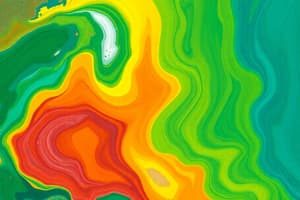Podcast
Questions and Answers
What is the main purpose of the Koppen System?
What is the main purpose of the Koppen System?
What characterizes Tropical Climates (A) in the Koppen System?
What characterizes Tropical Climates (A) in the Koppen System?
What is the subdivision of Dry Climates (B) in the Koppen System?
What is the subdivision of Dry Climates (B) in the Koppen System?
What is an example of a Temperate Climate (C) in the Koppen System?
What is an example of a Temperate Climate (C) in the Koppen System?
Signup and view all the answers
What is characteristic of Continental Climates (D) in the Koppen System?
What is characteristic of Continental Climates (D) in the Koppen System?
Signup and view all the answers
What is the subdivision of Polar Climates (E) in the Koppen System?
What is the subdivision of Polar Climates (E) in the Koppen System?
Signup and view all the answers
Study Notes
Overview
The Koppen System is a climate classification system developed by Wladimir Koppen in 1900.
Main Features
- Divides the world into five main climate zones:
- A: Tropical climates
- B: Dry climates
- C: Temperate climates
- D: Continental climates
- E: Polar climates
- Further subdivided into secondary and tertiary categories based on temperature, precipitation, and vegetation.
Main Climate Zones
-
A: Tropical Climates
- High temperatures and high humidity throughout the year
- No distinct seasons
- Examples: Amazon rainforest, Hawaii
-
B: Dry Climates
- Low humidity and limited precipitation
- Divided into:
- BWh: Hot desert climates (e.g. Sahara Desert)
- BWk: Cold desert climates (e.g. Gobi Desert)
-
C: Temperate Climates
- Mild winters and warm summers
- Divided into:
- Cfa: Humid subtropical climates (e.g. southeastern United States)
- Cfb: Temperate oceanic climates (e.g. western Europe)
-
D: Continental Climates
- Large diurnal temperature ranges and low humidity
- Divided into:
- Dfa: Humid continental climates (e.g. northeastern United States)
- Dfb: Continental subarctic climates (e.g. northern Canada)
-
E: Polar Climates
- Extremely cold temperatures and low humidity
- Divided into:
- ET: Tundra climates (e.g. Arctic tundra)
- EF: Ice cap climates (e.g. Antarctica)
Koppen Climate Classification System
- Developed by Wladimir Koppen in 1900
- Divides the world into five main climate zones
Main Climate Zones
-
A: Tropical Climates
- High temperatures and high humidity throughout the year
- No distinct seasons
- Examples: Amazon rainforest, Hawaii
Dry Climates
- Characterized by low humidity and limited precipitation
- Subdivided into:
-
BWh: Hot Desert Climates
- Examples: Sahara Desert
-
BWK: Cold Desert Climates
- Examples: Gobi Desert
-
BWh: Hot Desert Climates
Temperate Climates
- Mild winters and warm summers
- Subdivided into:
-
Cfa: Humid Subtropical Climates
- Examples: Southeastern United States
-
Cfb: Temperate Oceanic Climates
- Examples: Western Europe
-
Cfa: Humid Subtropical Climates
Continental Climates
- Large diurnal temperature ranges and low humidity
- Subdivided into:
-
Dfa: Humid Continental Climates
- Examples: Northeastern United States
-
Dfb: Continental Subarctic Climates
- Examples: Northern Canada
-
Dfa: Humid Continental Climates
Polar Climates
- Extremely cold temperatures and low humidity
- Subdivided into:
-
ET: Tundra Climates
- Examples: Arctic tundra
-
EF: Ice Cap Climates
- Examples: Antarctica
-
ET: Tundra Climates
Studying That Suits You
Use AI to generate personalized quizzes and flashcards to suit your learning preferences.
Description
Learn about the Koppen climate classification system, developed by Wladimir Koppen in 1900, which divides the world into five main climate zones: Tropical, Dry, Temperate, Continental, and Polar climates.




